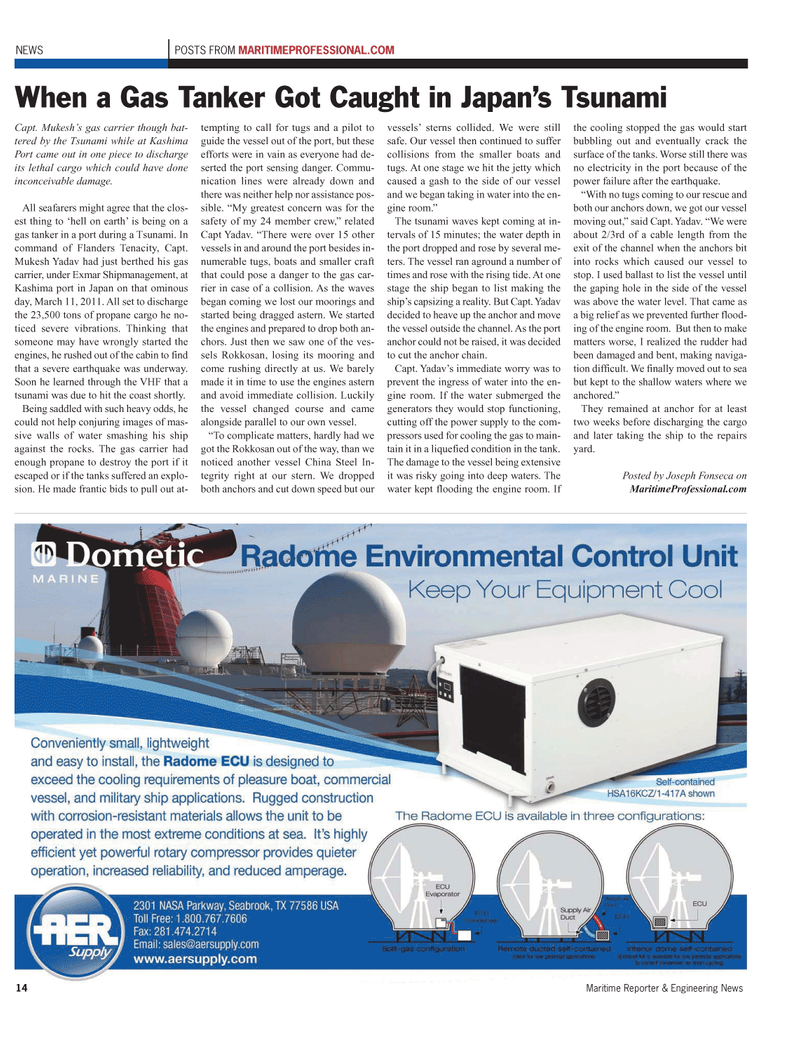
Page 14: of Maritime Reporter Magazine (June 2011)
Feature: Annual World Yearbook
Read this page in Pdf, Flash or Html5 edition of June 2011 Maritime Reporter Magazine
14Maritime Reporter & Engineering News NEWSPOSTS FROM MARITIMEPROFESSIONAL.COMWhen a Gas Tanker Got Caught in Japans Tsunami Capt. Mukeshs gas carrier though bat- tered by the Tsunami while at Kashima Port came out in one piece to discharge its lethal cargo which could have done inconceivable damage. All seafarers might agree that the clos- est thing to hell on earth is being on a gas tanker in a port during a Tsunami. In command of Flanders Tenacity, Capt. Mukesh Yadav had just berthed his gas carrier, under Exmar Shipmanagement, at Kashima port in Japan on that ominousday, March 11, 2011. All set to discharge the 23,500 tons of propane cargo he no- ticed severe vibrations. Thinking that someone may have wrongly started the engines, he rushed out of the cabin to find that a severe earthquake was underway. Soon he learned through the VHF that a tsunami was due to hit the coast shortly. Being saddled with such heavy odds, he could not help conjuring images of mas-sive walls of water smashing his ship against the rocks. The gas carrier had enough propane to destroy the port if it escaped or if the tanks suffered an explo- sion. He made frantic bids to pull out at-tempting to call for tugs and a pilot toguide the vessel out of the port, but these efforts were in vain as everyone had de- serted the port sensing danger. Commu- nication lines were already down and there was neither help nor assistance pos- sible. My greatest concern was for the safety of my 24 member crew,? related Capt Yadav. There were over 15 other vessels in and around the port besides in- numerable tugs, boats and smaller craftthat could pose a danger to the gas car- rier in case of a collision. As the waves began coming we lost our moorings and started being dragged astern. We started the engines and prepared to drop both an-chors. Just then we saw one of the ves- sels Rokkosan, losing its mooring and come rushing directly at us. We barely made it in time to use the engines asternand avoid immediate collision. Luckily the vessel changed course and came alongside parallel to our own vessel. To complicate matters, hardly had we got the Rokkosan out of the way, than we noticed another vessel China Steel In- tegrity right at our stern. We dropped both anchors and cut down speed but our vessels sterns collided. We were still safe. Our vessel then continued to suffer collisions from the smaller boats andtugs. At one stage we hit the jetty which caused a gash to the side of our vessel and we began taking in water into the en- gine room.? The tsunami waves kept coming at in- tervals of 15 minutes; the water depth in the port dropped and rose by several me- ters. The vessel ran aground a number of times and rose with the rising tide. At one stage the ship began to list making the ships capsizing a reality. But Capt. Yadav decided to heave up the anchor and move the vessel outside the channel. As the port anchor could not be raised, it was decided to cut the anchor chain.Capt. Yadavs immediate worry was to prevent the ingress of water into the en- gine room. If the water submerged the generators they would stop functioning, cutting off the power supply to the com- pressors used for cooling the gas to main-tain it in a liquefied condition in the tank. The damage to the vessel being extensive it was risky going into deep waters. The water kept flooding the engine room. If the cooling stopped the gas would start bubbling out and eventually crack the surface of the tanks. Worse still there was no electricity in the port because of thepower failure after the earthquake. With no tugs coming to our rescue and both our anchors down, we got our vessel moving out,? said Capt. Yadav. We were about 2/3rd of a cable length from theexit of the channel when the anchors bit into rocks which caused our vessel to stop. I used ballast to list the vessel until the gaping hole in the side of the vessel was above the water level. That came as a big relief as we prevented further flood- ing of the engine room. But then to make matters worse, I realized the rudder had been damaged and bent, making naviga- tion difficult. We finally moved out to sea but kept to the shallow waters where we anchored.? They remained at anchor for at least two weeks before discharging the cargo and later taking the ship to the repairsyard. Posted by Joseph Fonseca on MaritimeProfessional.com

 13
13

 15
15
